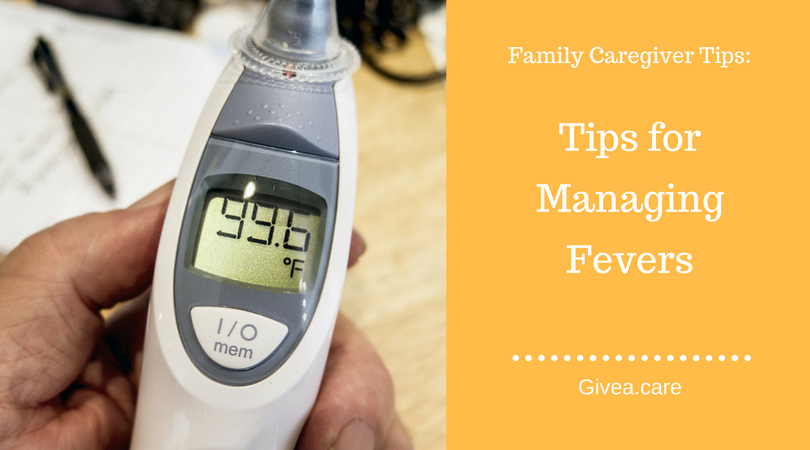Fever Management Tips for Caregivers
In caregiving, nothing gave me a scare quite like Mom spiking a sudden fever. In part because fevers triggered her epilepsy, but also because fevers were also often an indicator that she had an infection like a UTI or pneumonia. We became rather adept at recognizing and managing fevers over the years, and I thought I would share some tips we picked up:

Get a good thermometer – old-school under-the-tongue thermometers are traditional but might not be practical for your loved one. For us, they took too long to read a temperature and were difficult for Mom to use. Instead, we got a thermometer that could read Mom’s temperature via her forehead and her ear. We like how quick and efficient it was, however, I found out quickly that it displayed super crazy readings when even the littlest bit of earwax was on the tip where the sensor is.
When in doubt, always read your own temperature and then your loved one’s. If your reading seems way off, like 95.9 or something, clean the thermometer and try again. We had three different thermometer’s with us in case we didn’t trust a reading that was displayed. Also, learn to trust your touch. After so many years as her caregiver, I could feel Mom’s forehead and immediately know if she felt abnormally warm. This helped us take quick action.
Establish a baseline – we knew that Mom typically ran cold because her body had trouble maintaining an even temperature. She had multiple sclerosis which can affect temperature regulation in the body, as well as Parkinson’s symptoms which can affect autonomic functions like making sure the body is not too hot or cold. Knowing that Mom typically ran on the cooler side helped us recognize when temperature readings were abnormal – this is called establishing a baseline. A 99° temperature which isn’t quite a low-grade fever for a normal patient would indicate to us that Mom was heating up fast and heading towards fever-town.
Keep ice packs handy – the truth is, a fever is the body’s natural way of fighting off infection so having one isn’t all that bad. For someone with complex medical needs, however, a fever can be the first domino in a series of debilitating symptoms. In Mom’s case, fevers could quickly case her to have a seizure or simply to experience muscle contraction (fully body shaking) for 10 minutes to over an hour at a time. Stifling a fever quickly became second nature to us and it involved a lot of ice packs.
When applying cold to a person’s body, you always want to make sure there is some barrier between the ice pack and their skin. That might be a cover on the ice pack, a thin towel wrapped around it, or your loved one’s clothing. Next, you want to place ice packs in the most effective places to start cooling off the body – these include the head, back of the neck, armpits, and feet. We would also sometimes put an ice pack on her abdomen where her core was heating up the most.
Make medicine easy to administer – if your loved one is suffering from an infection that is causing their fever, that might not be the only symptom. Confusion, agitation, and disorientation may accompany their fever and therefore make it more difficult to administer them medicine to help bring their fever down. We kept liquid Tylenol and liquid Children’s Ibuprofen on hand because in a flash we could get a small dose together and have Mom drink it. That was so much easier than having to crush pills or give her tons of water to help her swallow a tablet.
Track and record – preventing complications and more fevers down the line is most effective when you are keeping close track and recording temperatures during spikes. This includes writing down the time, the body temperature, and what actions you took. You can refer back to this later as well as send this information to your loved one’s doctor, especially if your loved one does end up having an infection and they are wondering when symptoms began. We simply kept a spiral notebook in Mom’s room to write down details like this, however, making a note in your smartphone could also prove useful, especially if you needed it handy when you took your loved one to the doctor’s office.
How have you managed fevers with your loved one? Do you have any additional tips or tricks?

